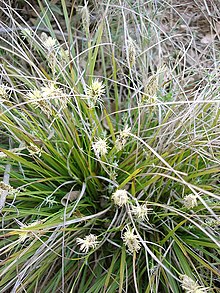Carex
| Carex | |
|---|---|
 |
|
| Carex halleriana | |
| Scientific classification | |
| Kingdom: | Plantae |
| (unranked): | Angiosperms |
| (unranked): | Monocots |
| (unranked): | Commelinids |
| Order: | Poales |
| Family: | Cyperaceae |
| Genus: |
Carex L. |
| Type species | |
|
Carex hirta L. |
|
| Diversity | |
| c. 1800 species | |
 |
|
| Global distribution of Carex (green) | |
Carex is a vast genus of almost 2,000 species of grassy plants in the family Cyperaceae, commonly known as sedges (or seg, in older books). Other members of the Cyperaceae family are also called sedges, however those of genus Carex may be called "true" sedges, and it is the most species-rich genus in the family. The study of Carex is known as caricology.
All species of Carex are perennial, although some species, such as C. bebbii and C. viridula can fruit in their first year of growth, and may not survive longer. They typically have rhizomes, stolons or short , but some species grow in tufts (caespitose). The culm – the flower-bearing stalk – is unbranched and usually erect. It is usually distinctly triangular in section.
The leaves of Carex comprise a blade, which extends away from the stalk, and a sheath, which encloses part of the stalk. The blade is normally long and flat, but may be folded, inrolled, channelled or absent. The leaves have parallel veins and a distinct midrib. Where the blade meets the culm there is a structure called the ligule. The colour of foliage may be green, red or brown, and "ranges from fine and hair-like, sometimes with curled tips, to quite broad with a noticeable midrib and sometimes razor sharp edges".
The flowers of Carex are small and are combined into spikes, which are themselves combined into a larger inflorescence. The spike typically contains many flowers, but can hold as few as one in some species. Almost all Carex species are monoecious; each flower is either male (staminate) or female (pistillate). A few species are dioecious. Sedges exhibit diverse arrangements of male and female flowers. Often, the lower spikes are entirely pistillate and upper spikes staminate, with one or more spikes in between having pistillate flowers near the base and staminate flowers near the tip. In other species, all spikes are similar. In that case, they may have male flowers above and female flowers below (androgynous) or female flowers above and male flowers below (gynecandrous). In relatively few species, the arrangement of flowers is irregular.
...
Wikipedia
